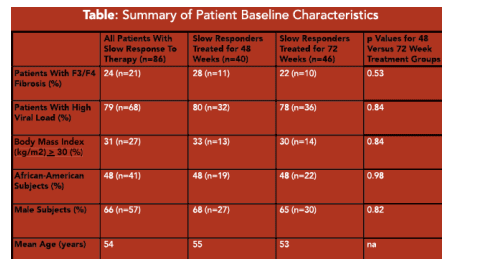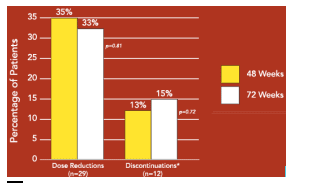 |
 |
 |
| |
72 Weeks Peg/RBV for 'Slow-Responders' Improves SVR Rate
|
| |
| |
Reported by Jules Levin
AASLD, Oct 27-31, 2006, Boston, MA
"Improved Virologic Response Rates With Treatment Extension to 72 Weeks PegIntron Plus Weight-based Ribavirin In a Difficult-To-Treat Population of Genotype 1-Infected Slow Responders"
Brian Pearlman1-4, C Ehleban2, S Saifee2.CDC1, Atlanta Medical Center, Atlanta, GA2, Medical College of GA, Aufgusta, GA3, Emory University School of Medicine, Atlanta, GA4
86 treatment-naive, chronically-infected HCV patients with elevated ALT and genotype 1 were enrolled in this single center study. Patients were treated with pegintron 1.5 mcg/kg/week and 800-1400 mg/day of ribavirin, dosed according to weight. Of note, as in the study reported at AASLD by Ferenci which I just emailed to you, all patients were slow-responders to therapy, defined as achieving at least a 2-log reduction in HCV RNA from baseline value, yet having detectable HCV RNA at 12 weeks (PCR, Taqman, Roche, detection limit 10 IU/ml). Patients were randomized 1:1 to continue treatment to complete a total of 48 or 72 weeks. HCV RNA was rechecked at week 24, at the end of treatment, and at the end of a 24 week treatment-free followup period.
Demographic, biochemical and virologic baseline characteristics were not statistically different between groups (Table). Overall, 48% of patients were African-Americans; 79% had high viral load; 24% had F3/4 fibrosis, and 31% had a body mass index of 30 or above. All patients had undetectable HCV RNA at 24 weeks of therapy. Dose reductions and treatment discontinuations for adverse events or lab abnormalities were similar between groups (Figure 1). The end-of-treatment response rates were significantly higher in the 72-week group compared to those in the 48-week group (54% vs 33%, respectively; p=0.04). Relapse rates were 28% in the 72-week group compared to 46% in the 48 week group (p=ns) (relapse rates were lower in 72 week group in Ferenci study). Overall, the rate of SVR was superior in patients treated for 72 weeks vs 48 weeks (39% vs 18%, p=0.03) (Figure 2).
AUTHORS CONCLUDE:
Extending treatment duration from 48 to 72 weeks in genotype 1 patients with slow virologic response to pegintron plus weight-based dose RBV significantly improves SVR rates. Treatment extension does not seem to increase rate of dose reduction or therapy discontinuation. Results should be confirmed.

Figure 1. Dose reductions and treatment discontinuations. No significant differences were seen between those slow responders treated for 48 weeks vs 72 weeks, includes both adverse events & lab abnormalities. (note from Jules Levin: but my guess is these data are for patients who remained on therapy while perhaps patients withdrew due to side effects were not captured in this graph).

|
| |
|
 |
 |
|
|